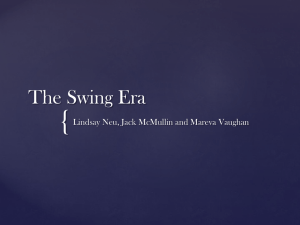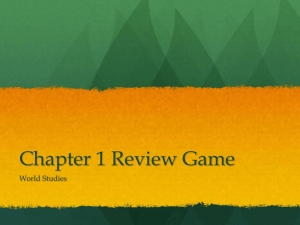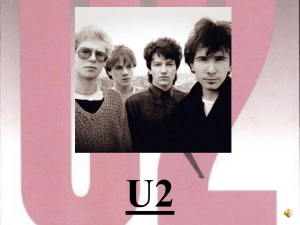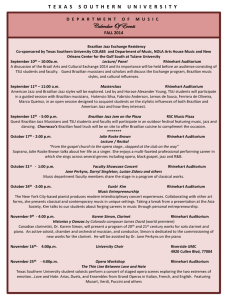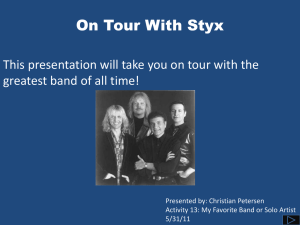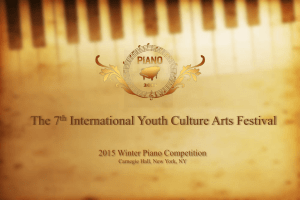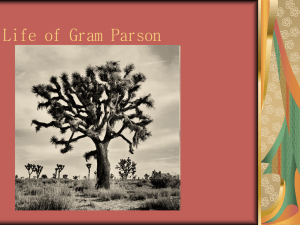Swing - midworld productions
advertisement
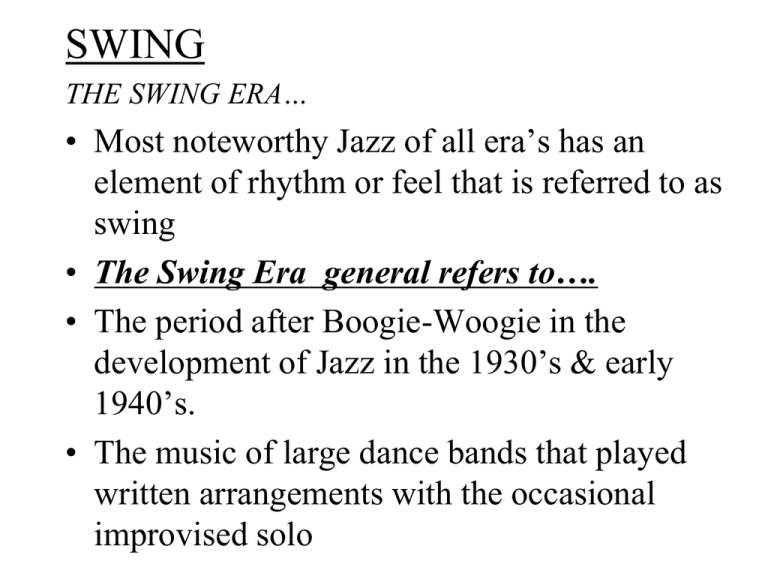
SWING THE SWING ERA… • Most noteworthy Jazz of all era’s has an element of rhythm or feel that is referred to as swing • The Swing Era general refers to…. • The period after Boogie-Woogie in the development of Jazz in the 1930’s & early 1940’s. • The music of large dance bands that played written arrangements with the occasional improvised solo THE SWING ERA • Across the country, there were literally hundreds of these “Big Bands”. • Most bands had similar instrumentations • Band leaders at the time were very concerned with having a Signature Sound. • They would try to achieve this by…. • Having unique arrangements of popular tunes • Having unique soloist THE SWING ERA THE BEGINNINGS… • Around 1924, New York bandleader Fletcher Henderson is credited with coming up with the pattern for SWING music arrangements . • It is the independent use of sections of instruments that set these apart • • • • • TRUMPETS TROMBONES SAXOPHONES RHYTHM (Piano/Guitar, String Bass, Drum-set) **note The Modern Drum-set begins to evolve *YOUTUBE KIT THE SWING ERA THE BEGINNINGS… • Formula of written for these instruments was copied by many of the dance bands. • Still used in today’s “Big Bands” = • Professional, College, & High School Bands • The idea of sections was to create more sonority (hierarchy) on the bandstand. • Henderson had some of the best players of the era in his band he used to establish this (..including Louis Armstrong) THE SWING ERA • Henderson took parts that were originally conceived to be played by on instrument and harmonized it for three of more. • Most bands would have different part or harmony for each instrument in each section. • In Kansas City, often times there would be one part for each section and all the instruments would play the “riff” in unison. THE SWING ERA • With these larger groups the Dixieland texture no longer was practical. • In Dixieland, everyone was allow improvisational freedom. • In Swing, only small opportunities for individual solos & improvisation were given in the larger composition call……. • THE JAZZ ARRANGMENT THE SWING ERA • THE JAZZ ARRANGMENT • Popular and original tunes taken and re-arranged for larger bands. • Every instrument ( sometimes even the Rhythm section) would have a note for note written out part. • This resembles in some way classical music scores. • Only small sections of the piece would be reserved for improvisation. • Unlike Dixieland, only one instrument would solo at a time. THE SWING ERA • THE JAZZ ARRANGMENT • The use of Ostinato fashion “Riffs” became common practice in arrangements. • Riff = repeated refrains or phrases that cause or create momentum and serve as catalysts that hold the music together from point to point. • Composed riffs would often times “back-up” an improvised solo. • These riffs help reign in, what some thought, was the over the top polyphony of Dixieland THE SWING ERA • THE JAZZ ARRANGMENT • LISTENING JOURNAL • FLETCHER HENDERSON & HIS ORCHESTRA • Wrappin’ It Up THE SWING ERA • NEW YORK (late 1920’s to early 1940’s) • Along with Kansas City most important geographically area in the development towards swing jazz. • Name bands were located or regular played New York. • Has a growing network of clubs and booking agents • Has a growing network of radio stations and recording studios. THE SWING ERA • NEW YORK (late 1920’s to early 1940’s) • Growing list of A-list Musicians come from New York. • Chick Webb band – young singer named ELLA FITZGERALD will bring them to prominence in the mid-30’s • Jimmie Lunceford – band that would inspire famous musicians. However, never nationally popular due to lack of recordings • Duke Ellington – proved that orchestration of a Jazz band was a true art form and became one of the most recognizable names in Jazz music • …....more on Sir Duke later THE SWING ERA • KANSAS CITY (late 1920’s to early 1940’s) • Bustling Mid-west city. • The mostly corrupt political establishment did much more than encourage the nightclub atmosphere. • Like Storyville before, many opportunities arose for Jazz musicians • Kansas City bands were looser more “riff” & blues based with less orchestration than New York groups. THE SWING ERA • KANSAS CITY (late 1920’s to early 1940’s) • Bennie Moten had the hottest band in KC but.. • MARY LOU WILLIAMS • One of the greatest performers to come out of KC • Great jazz pianist • Multi-talented = 1st woman to compose & arrange for a large jazz band (The Andy Kirk band) • Received many honors in her life including having a KC street named after her • * YOUTUBE VIDEOS THE SWING ERA • KANSAS CITY (late 1920’s to early 1940’s) • COUNT BASIE • In the early 1920’s Basie joined Bennie Moten’s band in New York & traveled to KC. • The band became stranded in KC. • Basie started his own band and most of Moten’s players came with him. • After Moten’s death Basie’s band becomes the leading band of KC THE SWING ERA • KANSAS CITY (late 1920’s to early 1940’s) • COUNT BASIE • The Basie band continued the musical advances started by earlier KC bands. • Basie anticipated the next era (Be-Bop) by… • 1. Freeing the Piano from merely just keeping time • 2. Created a “less is more” style of playing THE SWING ERA • KANSAS CITY (late 1920’s to early 1940’s) • COUNT BASIE • Basie anticipated the next era (Be-Bop) by… • 3. His composition style – • One main melody that leads to all the others & into solos • Letting the band have a hand in developing the final form. • ---------------• Also, his drummer Jo Jones added more interesting accents to his swing beats then previous KC drummers THE SWING ERA • KANSAS CITY (late 1920’s to early 1940’s) • COUNT BASIE • Listening Journal • Count Basie & His Orchestra • Taxi War Dance • *YOUTUBE – One O’Clock Jump • Basie’s signature tune THE SWING ERA • Swing becomes Accepted… • 1929 The Great Depression • Big Name Musicians including Armstrong & Ellington head for Europe. • Hotel music work survives • Radio positions survive • But rest of the entire music business almost completely collapses for a time. • Music is a luxury that most do without. THE SWING ERA • Swing becomes Accepted… • Some historians believe the Swing was launched around 1934 when a popular band leader Benny Goodman went back to playing concerts after working in radio during the 1st half of the Depression • Swing was around before 1934 with Fletcher Henderson, Duke Ellington, & Kansas City Band all getting their start before 1932. THE SWING ERA • Swing becomes Accepted… • A big catalyst to the start of the Swing era was the repel of Prohibition in 1933. • Night life changes with large clubs and ballrooms being able to book big bands to play dances and serve alcohol. • Dancing and drinking served as a distraction from the Depression • DVD SWING PURE PLEASURE 0:0014:00 THE SWING ERA • Paul Whiteman • Popular orchestra leader in New York , but not necessarily a Jazz musician or Jazz band leader • Even though he called himself THE KING OF JAZZ • He introduced George Gershwin’s “Rhapsody in Blue” in 1924 which became widely successful, and was mostly a classical composed piece with major Jazz elements. • *YOUTUBE – Rhapsody in Blue THE SWING ERA • Paul Whiteman • He steadily employed many “Name” Jazz musicians of the time even though the band didn’t always play Jazz or even Jazz influenced music. • Musicians included.. Bix Beiderbecke, Frank Trumbauer, Tommy & Jimmy Dorsey, ect.. • By providing them steady income it allowed them to maintain a career in music & develop as Jazz musicians • Eventually he’ll start a Jazz only group. THE SWING ERA • By the late 1930’s the Depression was coming to a close. • The Recording and Radio Industries were reemerging and helped publicize Jazz as the most listened to music in the world. • Benny Goodman has a series of Jazz concerts at Carnegie Hall which are milestones in the acceptance of Jazz. • Goodman is hailed as the King of Swing, even though large black orchestra’s had been doing the exact same thing for years. THE SWING ERA • GLENN MILLER • Lead what became the most popular of the Swing Bands – The Glenn Miller Orchestra • Miller was an outstanding arranger, Trombonist, & Businessman. • The band had… • Radio Program 3 nights a week • Many recordings • Made motion pictures -showmanship • *YOUTUBE – IN THE MOOD • DVD PURE PLEASURE band leaders 27:00 - 38:15 THE SWING ERA • Different bands had to…. • To find a signature sound & appeal • The role of the composer/arranger became important in this and help push Jazz music forward by developing many different but similar styles. • The other important element to creating a signature sound and an element that pushed Jazz forward was… • The Big-Band Soloist THE SWING ERA • The Big-Band Soloist • COLEMAN HAWKINS • • • • • Tenor Saxophone One of the leading Sax Improvisers Full Tone, Flowing Lines, Heavy Vibrato W/ Blues singer Mamie Smith 1922-23 Gains major recognition with Fletcher Henderson • Listening Journal • The Man I Love – Coleman Hawkins THE SWING ERA • The Big-Band Soloist • LESTER YOUNG • • • • • • Tenor Saxophone (slightly later than Hawkins in timeline) Great Tenor Soloist competing with Hawkins Went in a direction all his own Played softer, more subtle & abstract than Hawkins Will be the model for “Cool Jazz” Saxophonist Played with Count Basie’s Orchestra • Listening Journal • Lester Leaps In – Count Basie’s KC Six THE SWING ERA • The Big-Band Soloist • BENNY GOODMAN • Clarinet soloist and Big-Band Leader • Born in Chicago in 1909 to poor family • Begins playing young and word spreads by age 16 of his musicianship • Gets job playing on Radio & for Recording companies at age 20 in New York • In 1934, organizes his first band and begins touring. • Becomes a success and eventually plays the first swing band concert at Carnegie Hall THE SWING ERA • The Big-Band Soloist • BENNY GOODMAN • Has a Hollywood film based on his life • Tours the world on behalf of the US State Department • 1st band leader to force to issue of integration • Hailed as “The King of Swing” • Brought Jazz out of the backrooms & into the best night clubs and theaters of the day • Listening Journal • I Got Rhythm (written by George Gershwin) • –Benny Goodman Quartet THE SWING ERA • The Big-Band Soloist • GENE KRUPA • • • • • • Drummer With THE BENNY GOODMAN band Talented drummer and showman Drum kit was very close to modern set (Tom Toms) Inspirational drummer and soloist Keith Moon of “The Who” sights him as one of his major influences • **Youtube – Sing Sing Sing (Benny Goodman) • ** Youtube - drum battle w/ Buddy Rich THE SWING ERA • Swing Combos • Most big bands had small combo groups made of the better players in the band • Goodman had THE GOODMAN TRIO, QUARTET,& SEXTET • Artie Shaw had his “band within a band” THE GRAMERCY FIVE • Woody Herman = THE WOODCHOPPERS • Tommy Dorsey = THE CLAMBAKE SEVEN THE SWING ERA • Swing Combos • 52nd Street in New York had many clubs was a gathering place for these small combos • July 1944 , Norman Granz released a live jam session recorded in Los Angeles at a benefit concert. • First commercially successful “live” recording not made in a studio. • Marks a new phase in recording history • **Youtube = JAZZ AT THE PHILHARMONIC • DVD PURE PLEASURE 58:15 – 1:07:25 THE SWING ERA • • • • • • • • • THE DEMISE OF THE SWING ERA WWII helped end the swing era The draft took away some key plays in bands No gas or auto tires available to civilians making touring difficult at best The Cabaret Tax = puts many clubs out of business Rise in the popularity of “Singers” that fronted the bands…making the band less important The rise of “Rock & Roll” With the demise of Swing in major popularity the change to smaller ensembles of the Bebop era was taking shape. **DVD Pure Pleasure 1:21:15 - 1:24:00 THE SWING ERA • THE BIG BAND LEGACY • The Big Band is often equated to the Classical Symphony Orchestra • Big Band instrumentation was standardized the music was not…. • Most bands had Identifiable leader who was the symbol of the bands musical arrangements • Some bands have continued from the 1920’s to today • Members have changed and iconic leaders have died off • The names have stayed and the music vision of the original stays but has changed over the years THE SWING ERA • THE BIG BAND LEGACY • Big Band Legacy bands include… • THE DUKE ELLINGTON BAND • THE COUNT BASIE BAND • THE WOODY HERMAN BAND • THE STAN KENTON BAND • THE BUDDY RICH BAND…..ect • These bands often play nostalgic arrangements • …..but continue to introduce new material • …..and introduce new major talents • *YOUTUBE = Burning for Buddy (Neil Peart of Rush) THE SWING ERA • THE BIG BAND LEGACY • CONTEMPORARY BIG BANDS • Not all of the current Big Bands are Legacy or nostalgia bands • The medium has remained vital enough to support new bands and leaders such as…. • Doc Severinsen • Don Ellis • Mel Lewis • Quincy Jones • Louis Bellson • Bob Mintzer • Gerald Wilson • Ect… THE SWING ERA • CONTEMPORARY BIG BANDS • Doc Severinsen – • The Tonight Show with Johnny Carson • Quincy Jones – • Big band leader and producer who later has worked with acts from Michael Jackson to Will Smith & Usher. • Also scored soundtracks to projects like The Cosby Show, The Fresh Prince of Bel Air, Music for the Inauguration of Bill Clinton, The Color Purple, ect…. • Don Ellis – • Radical trumpeter and composer / band leader • Fuses styles from 20th century avant garde to Indian Raga • * YOUTUBE EXAMPLES
